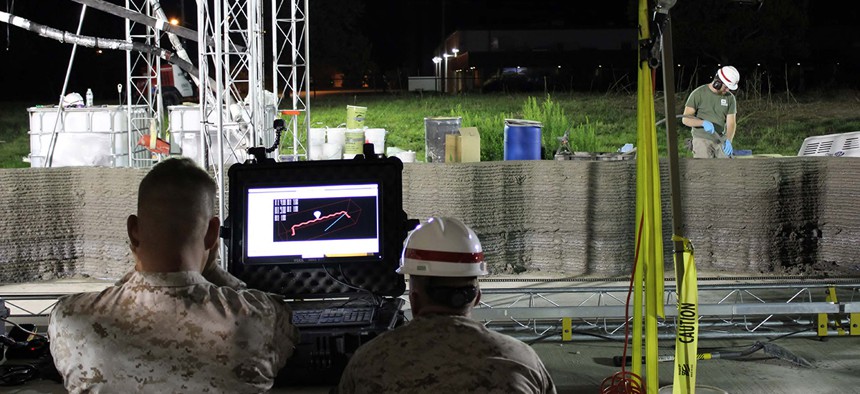Critical Update: How Marines Started 3D Printing Everything From Buckles to Barracks

Marines from I Marine Expeditionary Force monitor the computer while the world's largest concrete 3D printer constructs a 500-square-foot barracks hut at the U.S. Army Engineer Research and Development Center in Champaign, Illinois. U.S. Marines
Marines have a long history of MacGyver-ing what they need, but this unit has given them a 21st-century twist.
Getting supplies in a remote location can be difficult for America’s troops. Supply-line logistics is no easy task. But a group of Marines in the Advanced Manufacturing Operations Cell are finding ways to use 3D printers to make sure deployed troops can get whatever they need, from buckles to barracks.
Ahead of their presentation at the upcoming Bold Showcase, presented by Nextgov and Government Executive, Sam Pratt, a mechanical engineer at the Additive Manufacturing Project Office at Naval Sea Systems Command at the Carderock Naval Base, and Capt. Matthew Friedell, with the Marine Corps’ Rapid Sustainment Office, joined the Critical Update podcast to talk about how their program is changing the way Marines work and fight.
“We actually have a hotline set up for Marines to call in for support, just like an IT help desk,” Friedell said. “Except we’re there to respond to Marines’ materiel support—making things.”
“And to help give them some tools that are a little more capable than gum and toothpicks,” Pratt added. “They’re going to do it with gum and toothpicks anyway, right. But if we can push some capability that is maybe faster more capable, then that’s a net benefit.”
The printers have been used to make everything from custom buckles to, in one case so far, building an entire cement barracks in under 40 hours.
The technology has also been used to make and improve other technologies, like drones.
Once those drones are in use, Marines can work on customizing and otherwise altering the initial design to fit their needs. Then, Marines share their ideas with others and version 2.0 can be immediately pushed out to the rest of the corps.
Pratt and Friedell will be presenting their program as one of five initiatives highlighted at the annual Bold Showcase, set for Oct. 11 at the Longview Gallery in Washington, D.C.
But first, give a listen to our preview interview below or by subscribing through the Apple store or Google Play.






